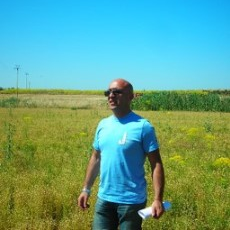Preprint
Article
Joint Action of Trichoderma atroviride and a Vegetal Derived-Protein Hydrolysate Improves Yield, Fruit Quality and Economic Profitability of Two Woodland Strawberry Cultivars Grown Under Greenhouse
This is a preprint, it has not been peer-reviewed.
Submitted:
18 March 2024
Posted:
19 March 2024
You are already at the latest version
A peer-reviewed article of this preprint also exists.
Abstract
Woodland strawberry (Fragaria vesca L.) is an underutilized plant species, appreciated by consumers for its qualitative features. Utilizing technical means of production, such as plant biostimulants, that can increase crop productivity and quality could be highly important in woodland strawberry cultivation. The scope of the present study was to appraise the influence of two biostimulants (Trichoderma atroviride and plant protein hydrolysate) - used either alone or combined - on plant performance and economic profitability of two woodland strawberry genotypes (‘Alpine’ and ‘Regina delle Valli’). Overall, data showed that ‘Alpine’ had the highest productive performances, whereas ‘Regina delle Valli’ revealed the highest fruit qualitative traits. T. atroviride inoculation and V-PH application significantly boosted plant marketable yield (+20.5% for T. atroviride and +12.9% for V-PH), total sugars (+1.9% for Trichoderma and +1.4% for V-PH) and anthocyanins (+14.1% for T. atroviride and +9.8% for V-PH) compared to non-treated plants. Plants supplied with both biostimulants had higher marketable yield (+34.8%), mean fruit weight (+6.0%), fruit dry matter (+13.8%), total sugars (+3.5%), ascorbic acid (+12.7%), flavonoid (+26.3%) and anthocyanins (+29.9%) compared to non-treated plants. Furthermore, our study revealed that the highest fruit polyphenols concentration was recorded in both genotypes treated with the combination of biostimulants and in ‘Regina delle Valli’ sprayed with V-PH, whereas the highest antioxidant activity was found in ‘Regina delle Valli’ fruit when plants were supplied with both biostimulants. Our study pointed out that the application of microbial and non-microbial biostimulants, especially in combination, might be an useful strategy for improving performances of underutilized species and, therefore, encourage its cultivation, valorisation and economic profitability (+10195.3 €/ha when plants were exposed to both biostimulants).
Keywords:
-
supplementary.docx (17.39KB )
1. Introduction
Small fruits represent a practical option due to their aptitude to produce prime quality food connected to a specific territorial setting, offering an additional source of income for the farmer. Woodland strawberry (Fragaria vesca L.) is one of the most elite small fruits and an imperative source of nutritional and functional components [1,2]. Although the strawberry (Fragaria × ananassa Duch.) chemical constituents have been deeply examined, a few evidence is reported for Fragaria vesca L., an herbaceous species that naturally grows in hilly or low-mountain areas [3]. Woodland strawberry fruits are characterized by a penetrating taste and aroma, habitually consumed fresh, or employed in pastry-making and in handled procedures. Nonetheless, fruits of woodland strawberry are challenging to find and are to be considered a niche product. Currently, a profitable trade production of F. vesca has been established in northernmost Italy (alpine area of Piedmont and Trentino) in open field or under mini tunnel [2]. Furthermore, Nin et al. [2] reported that - in Italy - woodland strawberry cultivation is also spread in Lazio (near to Rome) and in Campania (Salerno and Avellino) regions.
Woodland strawberry grown area is also located in Sicily, where various genotypes such as ‘Alpine’ and ‘Regina delle Valli’ cultivars and an endemic woodland ‘Fior di Noto’ are mainly cultivated in Marsala (Trapani Province). A local biotype ‘Fragolina di Ribera’, a Slow Food Presidia, is also grown in Sciacca and Ribera (Agrigento Province). In this scenario, woodland strawberry is generally cultivated in open filed (in soil cultivation) or under greenhouse (in soilless cultivation) [4]. Different authors [2,5] highlighted that woodland strawberry soilless cultivation is a very promising growing system, since it may reduce harvesting costs, which seriously affect the economic aspect of the crop, and also improve fruit quality.
Researches have indicated that microbial biostimulants supplied in crop production systems significantly trigger growth and yield, as well as nutritive and functional product quality [6,7,8]. Among microbial biostimulants, Trichoderma spp. are multipurpose fungi having various valuable functions, making them a promising means to promote agricultural sustainability. These ascriptions may embrace the capacity of Trichoderma spp. as biocontrol agents [9], plant growth promoter [10], as well as biofertilizers [11]. Furthermore, Trichoderma could alleviate plant abiotic distresses through the stimulation of endogenous mechanisms managed by phytohormones and the modifications in metabolism of host plants [12]. Within the non-microbial biostimulants panel, vegetal-protein hydrolysates (V-PH) is a promising group of plant biostimulants useful to shift from a resource-intensive to sustainable greenhouse production system, improving crop yield and quality [13]. The eclectic scientific literature concerning V-PH aforesaid effects is available, especially on fruiting and leafy vegetables. For instance, contemporary researches established that the application of V-PH augmented celery [14] and lettuce yield [15,16]. V-PH also improved the yield of tomato plants exposed to suboptimal nitrogen dose, upregulating gene expression for amino acid transporter and glutamine synthetase [17].
Despite the important research effort on the effects of biostimulants and natural products on vegetables [18,19], a boosted understanding concerning the blended supply of microbial and/or non-microbial biostimulants is required to make agriculture more resilient and green [20,21,22]. In this respect, to the best of our knowledge, there are no evidences on the impact of the combined use of Trichoderma atroviride, one of the most versatile species of genus Trichoderma, and of V-PH on yield and quality traits of woodland strawberry. Accordingly, the current study aimed at elucidating the effects of two biostimulants (Trichoderma atroviride and a plant protein hydrolysate) - used alone or in combination - on the performance and economic profitability of two woodland strawberry genotypes (‘Alpine’ and ‘Regina delle Valli’).
2. Materials and Methods
2.1. Plant Genetic Resources and Experimental Conditions
The study was conducted near Marsala (TP), in an experimental polyethylene covered greenhouse (37°44'53"N; 12°32'41"E), of the Agricultural, Food and Forestry Science Department - University of Palermo for two cultivation cycles (2018-2019 and 2019-2020). Two woodland Fragaria vesca L. genotypes were tested: ‘Alpine’ and ‘Regina delle Valli’. Plants were cultivated in an open soilless growing system. Strawberry plants were grown in a peat moos/coconut fibre (40/60, v/v) based substrate mix (FR-LA 21V, Vigorplant Fobio, LO, Italy), in 3 L plastic baskets, containing 1 plant. A density of 1.5 plants m-2 was adopted. Inside the greenhouse, a data logger was used to record the maximum and minimum air temperatures. Plants were watered, as described by Boztok et al. [23] and Gül and Sevgican [24], depending on solar radiation. Both cultivation cycles, started on 12th September and were concluded on 30th July. The nutrient solution adopted was the following: 10 mM/L of N-NO3, 1 mM/L of N-NH4, 1 mM/L of P-PO4, 5.5 mM/L of K, 3.5 mM/L of Ca, 1.2 mM/L of Mg, 2.0 mM/L of S-SO4, 20 mM/L of Fe, 30 µM/L of B, 1.0 µM/L of Cu, 5.0 µM/L of Zn, 10.0 µM/L of Mn and 1.0 µM/L of Mo.
2.2. Microbial and Non-Microbial Biostimulant Treatments
Two biostimulant treatments, a vegetal-derived protein hydrolysates TYSON® (Mugavero fertilizers, Palermo, Italy) (V-PH) and a Trichoderma atroviride AT10 strain (Condor - Atens - Agrotecnologias Naturales S.L, Tarragona, Spain) were applied to assess the single and combined effect on the two different woodland strawberry genotypes tested. The biostimulant TYSON® characteristics were reported in Table S1. Condor is a commercial product which contains 1 × 109 CFU g−1 of Tricoderma atroviride strain AT10.
Twenty-four hours before transplanting, the woodland strawberry plants were inoculated, soaking the roots for 15 minutes using a rate of 1 kg ha-1 of inoculum. From fifteen days after transplant (DAT) to final harvest, every 20 days woodland strawberry plants were sprayed with V-PH. Dosages of 0 ml L-1 (control) and 3 ml L-1 (recommended dose) were supplied, using 100 mL of solution per plant. Control plants were sprayed with only water.
2.3. Yield and Fruit Nutritional Traits
Yield traits were documented for all plants. Marketable yield and mean fruit weight were evaluated. Marketable fruits were defined as fruits not affected by any visible disease or deformity. The marketable yield was expressed as g plant-1, while mean fruit weight was expressed as g.
For the determination of nutritional features, fruits from 3rd to 6th harvest were randomly collected. Dry matter values, expressed as a percentage, were determined by drying 80 g of fresh sample in a ventilated oven, set first at 70°C for 24 h and afterwards at 105 °C for 48 h. To determine the firmness of the fruit, the measurement was carried out with a digital penetrometer to test the resistance to compression. A cylindrical stainless-steel probe with a diameter of 3 mm was used for the measurement. The fruit firmness value was expressed in Newtons (N). To measure total soluble solids (TSS), woodland strawberry juice was obtained by centrifuging the fruit and filtering. A digital refractometer was used for the analysis and the data were expressed as °Brix. Total sugar concentration was determined by the method of Serna et al. [25] and results were expressed as mg 100 g-1 of fresh weight. The fruit ascorbic acid content was performed via a refractometer with the use of Reflectoquant Ascorbic Acid Test Strip. The results were presented as mg 100 g-1 fresh weight.
2.4. Fruit Function Traits and Antioxidant Activity
The total flavonoid content was calculated as Najda et al. [26]. Briefly, the absorbance was measured at 425 nm via a spectrophotometer and then calculating the flavonoid content according to the equation x = (8.75×A)/m, where m is the amount of fresh material. The results were expressed as mg g-1 of fresh weight. The anthocyanin content was calculated according to the method of Rabino and Mancinelli [27]. The results were expressed as mg of Cya-3-glucoside equivalent per 100 g−1 fresh weight. Total polyphenols were analysed by spectrophotometric assay, as described by Doumett et al. [3]. The results were reported as milligrams of (+)-catechin per 100 g of berries fresh weight. Antioxidant activity was determined following the Chen and Ho [28] method and expressed as %DPPH.
2.5. Experimental Setup and Statistical Analysis
Four biostimulant applications (T. atroviride, V-PH, T. atroviride + V-PH and control) were combined with two woodland strawberry genotypes (‘Alpine’ and ‘Regina delle Valli’) in a two-factorial experiment, obtaining 8 treatments. For each treatment 30 plants were used (3 replicates of 10 plants), resulting in a total of 240 plants organized in a randomized complete block design (RCBD). The trial was replicated for two consecutive cultivation cycles. Statistical analyses were performed using SPSS v.28 (SPSS Inc., Chicago, IL, USA). The effects of biostimulant and the genotypes were evaluated using a two ways-ANOVA, setting genotype and biostimulant as main factors. Multiple comparisons were performed applying tukey’s test (p<0.05). To evaluate the year effect, an initial three-way ANOVA (genotype × biostimulant × year) was performed. To sum up all traits, a heat map was also generated using the online program package clustvis (https://biit.cs.ut.ee/clustvis/ (accessed on 01 February 2024).
2.6. Partial Budget Analysis
A partial budget analysis was developed to assess the net economic gains that may promote the woodland strawberry cultivation via the application of V-PH and T. atroviride, individually or in combination. The economic procedure reported by Giordano et al. [29] was employed. The biostimulants added costs and gross returns were considered. The following formula was applied to evaluate the added net return generated by V-PH, T. atroviride and by their combination: Added net return = added gross return − added variable costs.
3. Results
The trial was repeated for two consecutive years adopting the same experimental scheme. Since ANOVA did not show statistical differences between experimental years (Table S2), data from 2018-2019 growing cycle are presented.
3.1. Yield, Fruits Qualitative and Nutraceutical Traits
The marketable yield and mean fruit weight were significantly modulated by genotype and biostimulant, but not by their interaction (Figure 1a and 1b).
Notwithstanding of the biostimulant, ‘Alpine’ showed higher marketable yield (+34.2%) than “Regina delle Valli” genotype (Figure 1a). On the other hand, biostimulants boosted marketable yield; the highest values were noted in woodland strawberry plant treated with T. atroviride + V-PH (+34.8% compared to control), followed by those inoculated with T. atroviride. Averaged over the biostimulant, the highest mean fruit weight was recorded in “Alpine” genotype (Figure 1b). Moreover, the plants biostimulated with V-PH or T. atroviride + V-PH showed the highest mean fruit weight, whereas, woodland strawberry plants inoculated with T. atroviride or control plants had the lowest ones.
As shown in Table 1, statistical analysis for fruit dry matter, fruit firmness, total soluble sugars (TSS), total sugars and ascorbic acid did not expose a significant effect of the interaction biostimulant × genotype.
Irrespective of the biostimulant treatment, ‘Regina delle Valli’ genotype showed the highest fruit dry matter content and the highest total sugar and ascorbic acid concentration, whereas fruit firmness and TSS peaked in ‘Alpine’ strawberry. Regardless of the genotype, plants treated with T. atroviride + V-PH had the highest fruit dry matter content, followed by those treated with T. atroviride and those treated with V-PH (Table 1). The lowest dry matter percentage was detected in fruits from control plants. Averaged over genotype, fruits from plant treated with T. atroviride displayed the highest firmness, followed by those from plants supplied with T. atroviride and V-PH. Control plants had the lowest values. Without regard of the genotype, fruits from control plants and those from plants inoculated with T. atroviride showed the highest TSS followed by those from plant supplied with V-PH or with T. atroviride + V-PH (Table 1). Data on total sugars overlaped with those described for fruit dry matter. Regardless of the genotype, fruits from plants supplied with both biostimulants or with V-PH showed a higher ascorbic acid content than fruits from plants inoculated with T. atroviride or control plants (Table 1).
ANOVA for flavonoids and anthocyanins did non highlight a significant biostimulant × genotype interaction (Figure 2a and 2b).
Flavonoids concentration peaked in fruits from “Regina delle Valli” plants (Figure 2a). Moreover, regardless of the genotype, berries from plants supplied with T. atroviride + V-PH had the highest flavonoids content, followed by those supplied with V-PH; the lowest values were assessed in control plants or in woodland strawberry plants inoculated with microbial biostimulant. For anthocyanins, data showed that fruits from ‘Regina delle Valli’ had higher values than those from ‘Alpine’. Averaged over genotype, the highest anthocyanins concentrations were found in berries from plants treated with T. atroviride + V-PH, followed by those from plants supplied with T. atroviride or with V-PH. For total polyphenols and antioxidant activity, the two experimental factors significantly interacted (Figure 2c and 2d). As concerns total polyphenols, the highest values were recorded in fruits from ‘Alpine’ or ‘Regina delle Valli’ genotype treated with T. atroviride + V-PH and in fruits from ‘Regina delle Valli’ plants sprayed with V-PH (Figure 2c). The lowest values - for fruit total polyphenols concentration - were recorded in ‘Alpine’ control plants or in those inoculated with T. atroviride. For antioxidant activity, the highest values were observed in fruits from ‘Regina delle Valli’ exposed to the T. atroviride + V-PH treatment, followed by those from the ‘Regina delle Valli’ × V-PH combination. The lowest values were detected in fruits from ‘Alpine’ control plots.
3.2. Heat-Map
A heat-map analysis of all tested parameters was performed to summarize the influence of all experimental factors on woodland strawberry plants (Figure 3).
The graphical analysis shows two dendrograms. The first dendrogram (Dendrogram 1), located on the top, containing the 8 treatments. The second dendrogram (Dendrogram 2), located on the left side of the figure, involves the depended variables, affecting the distribution. Dendrogram 1 showed two main clusters, the group on the left include the combination with ‘Regina delle Valli’ (RDV) genotype, whereas the group on the right includes the combination with ‘Alpine’ (A) genotype. In particular, the combination RDV × V-PH and RDV × T. atroviride + V-PH were separated from those RDV × control and RDV × T. atroviride. The latter combinations showed lower values of ascorbic acid, dry matter, total sugars, anthocyanins, flavonoids, total polyphenols and antioxidant activity, mean fruit weight and marketable yield than RDV × V-PH and RDV × T. atroviride + V-PH combinations, however, they revealed higher values in terms of fruit firmness and TSS. The cluster on the left comprised RDV × V-PH and RVD × T. atroviride + V-PH combinations. In this group RDV × V-PH treatment showed the lowest dry matter, total sugar, anthocyanins, antioxidant activity, fruit firmness, marketable yield and TSS values. Meanwhile, the grouping on the right contained the RDV × control and RDV × T. atroviride combinations. Within this cluster, the RDV × T. atroviride combination was characterized by a higher total sugar, anthocyanins, fruit firmness and marketable yield compared with RDV × control treatment. In the right site of dendrogram 1, two main clusters were documented. Specifically, A × control and A × T. atroviride were split from those A × V-PH and A × T. atroviride + V-PH. A × control and A × T. atroviride revealed lower values of ascorbic acid, dry matter, total sugars, anthocyanins, flavonoids, total polyphenols and antioxidant activity, and marketable yield than A × V-PH and A × T. atroviride + V-PH combinations. Nonetheless, A × control and A × T. atroviride had higher values in terms of fruit firmness and TSS. The cluster on the left comprised A × control and A × T. atroviride combinations. In this group A × control treatment shows the lowest dry matter, total sugar, anthocyanins, flavonoids, antioxidant activity, fruit firmness and marketable yield. Concomitantly, the cluster on the right enclosed A × V-PH and A × T. atroviride + V-PH combinations. Within this cluster A × T. atroviride + V-PH treatment was characterized by a higher dry matter, total sugar, anthocyanins, total polyphenols, antioxidant activity, fruit firmness, marketable yield and TSS compared with A × V-PH combination.
3.3. Partial Budget Analysis of Biostimulants-Treated Woodland Strawberry Production
The biostimulant effects on yield increase is presented in Table 2. The economic evaluation highlighted a beneficial impact of T. atroviride (6631.5 €/ha), V-PH (3091.8 €/ha) and T. atroviride + V-PH (10193.5 €/ha), with the maximum added gross return observed in woodland strawberry treated with both biostimulants (Table 2). Among the counted added variable costs, the harvest related to the yield increase was the main cost element, followed by biostimulant treatments (Table 2). Overall, our results underlined that the enhanced net economical benefit was related with the yield increase. Particularly, using both biostimulants (T. atroviride + V-PH) was more profitable than using them alone.
Costs of biostimulants were furnished by suppliers (TYSON® = 10.5 €/kg; Condor® = 150.0 €/kg); costs of biostimulants application were considered reputable on the information provided by local agricultural contractors.
4. Discussion
Neglected and underutilized species, such as woodland strawberry (Fragaria vesca L.), are very important in the context of biodiversity preservation [30,31,32,33]. However, such species have often lower performance than commercially hybrids and, therefore, they are under-cultivated [34]. The use of sustainable technical means, such as biostimulants, could be a successful strategy to promote neglected and/or underutilized species cultivation through the increase of yield and quality. This research investigated the response of two woodland strawberry genotypes (‘Alpine’ and ‘Regina delle Valli’) to the application of Trichoderma atroviride and vegetal protein hydrolysate, employed alone or in combination. Our study revealed significant differences in terms of productive and qualitative performances between the genotypes. ‘Alpine’ genotype had higher marketable yield and mean fruit weight than ‘Regina delle Valli’. These outcomes are corroborated by those of Nin et al. [2], who studied the potential use of alternative growing systems for the cultivation of the woodland strawberry genotypes.
In our study ‘Alpine’ woodland strawberry revealed higher fruit firmness and TSS compared to ‘Regina delle Valli’. Contrariwise, ‘Regina delle Valli’ had higher fruit dry matter, total sugars, ascorbic acid, anthocyanins, polyphenols and antioxidant activity than ‘Alpine’. Overall, data suggest that productive performances were higher in ‘Alpine’, whereas most of the qualitative traits were higher in ‘Regina delle Valli’. These data are corroborated by those of Doumett et al. [3] who, by comparing the nutritional and nutraceutical traits of different Fragaria vesca genotypes, reported that - overall – ‘Regina delle Valli’ had higher qualitative features than ‘Alpine’.
Woodland strawberry plants treated with biostimulants had higher marketable yield than non-biostimulated ones. The effect of Trichoderma spp. on yield parameters can be attributed to its biofertilizer properties since it has been showed that inoculation increases the nutrient availability via the variation of plant root architecture and the production of siderophores and organic acids [35,36,37]. Moreover, as reported by Kotasthane et al. [38] and Casimiro et al. [39], Trichoderma can secrete plant hormones like indol-acetic acid (IAA), which in turn promote plant growth and yield. The positive effect of V-PH on yield can be mainly related to its role in the elicitation of plant primary metabolism [40]. Amino acids contained in V-PH are the main organic nitrogen transporters and they can also be used for protein synthesis [41]. Our research also underlined that plants supplied with both biostimulants had the highest marketable yield. This outcome can be interpreted as a synergistic effect between T. atroviride and V-PH in enhancing plant yield. For mean fruit weight, plants treated with both biostimulants did not reveal statistically significant difference as compared with plants treated with only V-PH. Consequently, we may assume that the main increasing effect was prompted by the V-PH application.
Fruit dry matter percentage was increased by biostimulants supply. These data concur with those of Colla et al. [42], who found an increase in the dry matter of several vegetable crops when inoculated with Trichoderma. Moreover, data overlapped with those of Chen et al. [43] who reported that Pakchoi plants (Brassica chinensis L.) treated with two Trichoderma strains has higher dry weight than non-treated ones. The increasing effect recorded can be attributed to the role of Trichoderma on plant mineral nutrition, with particular reference to nitrogen and phosphorous uptake [35]. Moreover, as stated by Colla et al. [41], the enhancement of dry matter recorded in PH-treated plants can be related to the amino acids contained in V-PH which influence nitrogen metabolism via the modulation of N accumulation and transport. Since the highest fruit dry matter content was recorded in plants treated with both biostimulants (T. atroviride + V-PH), we may assume that the two biostimulants interacted synergistically.
Fruit firmness is a notable fruit qualitative trait of woodland strawberry, influencing transport and consumer appreciation. Fruit firmness was reduced by V-PH application and increased by T. atroviride inoculation. These results differ from those of Cozzolino et al. [44], who found a significant increase of fruit firmness when tomato plants were supplied with plant protein hydrolysate. Moreover, Soteriou et al. [45] found that plant protein hydrolysate did not influence watermelon fruit firmness. Consequently, due to these contrasting results, we can speculate that the different plant responses to V-PH depended on plant species (strawberry, watermelon and tomato). Conversely, the positive effect of Trichoderma on fruit firmness can be related to its ability to solubilize calcium phosphate [46] and, consequently, increase fruit firmness [47]. The mutual application of biostimulants increase fruit firmness compared to the control, however, in this case it seems that the biostimulants did not act synergistically.
In our research, total soluble solids (TSS) concentration was not affected by the inoculation with T. atroviride, whereas it was reduced by V-PH application. These results are coherent with those of Fernando et al. [48] who, by testing the biostimulant activity of Trichoderma on melon, revealed no significant effect of the inoculation on TSS. However, findings were in contrast with those of Apostol et al. [49], who reported that Trichoderma inoculation modulate pepper fruit TSS depending on genotype. Moreover, findings are in contrast with those of Colla et al. [50], who reported an increase of tomato TSS when plants were exposed to PH. Furthermore, Soppelsa et al. [51] reported no significant effect of PH on strawberry (Fragaria × ananassa) fruit TSS. The contrasting results obtained can be explained as a different plant response to V-PH and Trichoderma application, suggesting its genotype dependence.
Total sugars were boosted by biostimulants application. Data concur with those of Sani et al. [52], who observed an enhancement in terms of total sugars in tomato fruits when plants were inoculated with Trichoderma. Also, our results agree with those of Sabatino et al. [15], who found an up surge of total sugars in lettuce plants treated with PH. Since sugars were produced via photosynthesis and considering that this process is directly related to plant primary photochemical reactions [53], we may assume that both biostimulants enhanced woodland strawberry plant photosynthesis capacity. Interestingly, the highest total sugars values were assessed in plants supplied with both biostimulants, suggesting a synergistic effect between them.
Ascorbic acid in fruits was only enhanced by V-PH application. Data agreed with Rouphael et al. [54] who, assessing the impact of a plant PH on tomato, reported an improve in fruit ascorbic acid concentration, when plants were treated with V-PH. Moreover, results concurred with those of other authors [55,56] on tomato and pepper. The effect of V-PH on ascorbic acid can be linked to the modulation of plant secondary metabolism, via enzymes involved in phytochemical homeostasis and in the variation of plant nutritional status [13]. Moreover, V-PH stimulate the biosynthesis of some amino acids like phenylalanine and tyrosine, precursors of ascorbic acid synthesis [14]. However, considering that the highest ascorbic acid value was found in berries from plants treated with V-PH or exposed to both biostimulants, we can affirm that Trichoderma did not have an antagonistic effect when combined with V-PH.
Flavonoids were enhanced by V-PH applications. These findings tied well with those of Ertani et al. [57] who, by conducting a study on the effect of PH on maize, revealed that the application of PH elicited flavonoids biosynthesis. The flavonoid increase is related to the variation of some enzyme, such as phenylalanine ammonia lyase (PAL), comprised in phenyl-propanoid production [41]. Indeed, it was showed that the gene encoding for PAL can be encouraged by biostimulants application [57,58]. Remarkably, we found the highest flavonoid values in fruits from plants subjected to both biostimulants. This outcome was also detected by Rouphael et al. [59] on lettuce. Moreover, since Trichoderma grows thanks to the sugars taken up by the plants [41] and considering that the combination of the two biostimulants revealed the highest total sugars content, we may hypothesize that Trichoderma effect on flavonoids was boosted.
Anthocyanins were enhanced by both biostimulants, applied alone or in combination. Data agree with those obtained by Lombardi et al. [60], who reported an increase of anthocyanins when strawberry plants were inoculated with Trichoderma. The Trichoderma mechanism of action is mainly connected to the PAL and chorismate synthase production and, consequently, the phenylpropanoid pathway, which in turn is related to anthocyanins biosynthesis [60]. Interestingly, fruits from plants treated with both biostimulants had the highest anthocyanins values, revealing a synergistic effect between Trichoderma and V-PH.
Results underlined that V-PH significantly enhanced total polyphenols. These data agree with Parrado et al. [61] and with Gurav and Jadhav [62]. Furthermore, as reported by Zhou et al. [63], the increase in phenolic components can be directly related to the “ex novo” synthesis of phenolic compounds via the activation of plant defence genes, such as PAL. Phenolic production could be also related to the amino acids contained in the V-PH (phenylalanine and tyrosine), which stimulate phenolics biosynthesis. Moreover, as stated by Zhou et al. [64], the nitrogen metabolism – modulated by V-PH application - is related to phenolics production. Data on total polyphenols showed that ‘Alpine’ and ‘Regina delle Valli’ genotypes reacted differently to biostimulants application. Particularly, ‘Alpine’ revealed the highest values when treated with both biostimulants, whereas ‘Regina delle Valli’ had the highest values when treated with V-PH or with T. atroviride + V-PH.
The inoculation with Trichoderma had no effect on antioxidant activity, while V-PH application increased it. This is in line with Nzanza et al. [65], who found no significant effect of Trichoderma on tomato antioxidant activity. Moreover, our study is in accordance with Caruso et al. [66], Ertani et al. [55] and Colla et al. [50] on Diplotaxis tenuifolia, pepper and tomato, respectively, who reported an increase of the antioxidant activity in PH-treated plants. Moreover, the increase of antioxidant activity can be linked to the activation of vital enzymes comprised in cell antioxidant homeostasis [66]. The antioxidant activity was significantly influenced by the mutual application of biostimulants, underlining a synergistic effect, especially in ‘Regina delle Valli’ genotype.
5. Conclusions
The cultivation of underutilized species, such as woodland strawberry, could play an important role in the preservation of biodiversity. This study investigated the impact of two biostimulants (Trichoderma atroviride and plant protein hydrolysate) - used alone or in combination - on the performances of two woodland strawberry genotypes. Data showed that ‘Alpine’ had the highest productive performances, whereas - in general - ‘Regina delle Valli’ performed better than ‘Alpine’ in terms of qualitative traits. Moreover, our research underlined that Trichoderma inoculation and V-PH supply significantly boosted plant marketable yield, total sugars and anthocyanins compared to non-treated plants. Remarkably, the highest marketable yield, mean fruit weight, fruit dry matter, total sugars, ascorbic acid, flavonoid, anthocyanins, total polyphenols and antioxidant activity were observed when woodland strawberry plants were simultaneously exposed to both biostimulants. Our study underlined that the use of biostimulants could be an effective strategy to increase plant performance and economic profitability of woodland strawberry, and - concomitantly - to enhance sustainability and resilience of its greenhouse cultivation system.
Supplementary Materials
The following supporting information can be downloaded at the website of this paper posted on Preprints.org.
Author Contributions
Conceptualization, L.V., B.B.C, S.L.; methodology, L.V., E.A., B.B.C., S.N., S.V., S.B.; software, L.V., B.B.C., P.B., L.S.; validation, L.S., G.N., S.L.B., C.L.; formal analysis, L.V., E.A., P.B., S.V., S.B. C.C.; investigation, L.V., E.A., B.B.C., P.B., S.N., S.L.B., C.L.; resources, L.S.; data curation, L.V., B.B.C., L.S.; writing—original draft preparation, L.V., B.B.C:, G.N., L.S.; writing—review and editing, L.V., B.B.C:, C.C., G.N., L.S.; visualization, L.V., L.S.; supervision, L.S., G.N.; project administration, L.S.; funding acquisition, L.S.. All authors have read and agreed to the published version of the manuscript.
Funding
This research received no external funding.
Data Availability Statement
not applicable.
Acknowledgments
The authors thank Mugavero fertilizers for providing the TYSON® vegetal derived-protein hydrolysate.
Conflicts of Interest
The authors declare no conflicts of interest.
References
- Del Bubba, M.; Giordani, E.; Ancillotti, C.; Petrucci, W.A.; Ciofi, L.; Morelli, D.; Marinelli, C.; Checchini, L.; Furlanetto, S. Morphological, Nutraceutical and Sensorial Properties of Cultivated Fragaria vesca L. Berries: Influence of Genotype, Plant Age, Fertilization Treatment on the Overall Fruit Quality. Agric. Food Sci. 2016, 25. [Google Scholar] [CrossRef]
- Nin, S.; Petrucci, W.A.; Giordani, E.; Marinelli, C. Soilless Systems as an Alternative to Wild Strawberry (Fragaria vesca L.) Traditional Open-Field Cultivation in Marginal Lands of the Tuscan Apennines to Enhance Crop Yield and Producers’ Income. J. Hortic. Sci. Biotechnol. 2018, 93, 323–335. [Google Scholar] [CrossRef]
- Doumett, S.; Fibbi, D.; Cincinelli, A.; Giordani, E.; Nin, S.; Del Bubba, M. Comparison of Nutritional and Nutraceutical Properties in Cultivated Fruits of Fragaria vesca L. Produced in Italy. Food Res. Int. 2011, 44, 1209–1216. [Google Scholar] [CrossRef]
- Caracciolo, G.; D’Anna, E.; Moncada, A.; D’Anna, F. Evaluation of the Quality and Antioxidant Capacity of Woodland Strawberry Biotypes in Sicily. 2013.
- Caruso, G.; Villari, G.; Melchionna, G.; Conti, S. Effects of Cultural Cycles and Nutrient Solutions on Plant Growth, Yield and Fruit Quality of Alpine Strawberry (Fragaria vesca L.) Grown in Hydroponics. Sci. Hortic. 2011, 129, 479–485. [Google Scholar] [CrossRef]
- Sabatino, L.; Iapichino, G.; Consentino, B.B.; D’Anna, F.; Rouphael, Y. Rootstock and Arbuscular Mycorrhiza Combinatorial Effects on Eggplant Crop Performance and Fruit Quality under Greenhouse Conditions. Agronomy 2020, 10, 693. [Google Scholar] [CrossRef]
- Consentino, B.B.; Aprile, S.; Rouphael, Y.; Ntatsi, G.; De Pasquale, C.; Iapichino, G.; Alibrandi, P.; Sabatino, L. Application of PGPB Combined with Variable N Doses Affects Growth, Yield-Related Traits, N-Fertilizer Efficiency and Nutritional Status of Lettuce Grown under Controlled Condition. Agronomy 2022, 12, 236. [Google Scholar] [CrossRef]
- Consentino, B.B.; Sabatino, L.; Vultaggio, L.; Rotino, G.L.; La Placa, G.G.; D’Anna, F.; Leto, C.; Iacuzzi, N.; De Pasquale, C. Grafting Eggplant Onto Underutilized Solanum Species and Biostimulatory Action of Azospirillum brasilense Modulate Growth, Yield, NUE and Nutritional and Functional Traits. Horticulturae 2022, 8, 722. [Google Scholar] [CrossRef]
- Sachdev, S.; Singh, R.P. Isolation, Characterisation and Screening of Native Microbial Isolates for Biocontrol of Fungal Pathogens of Tomato. Clim. Change Environ. Sustain. 2018, 6, 46. [Google Scholar] [CrossRef]
- Sachdev, S.; Singh, A.; Singh, R.P. Optimization of Culture Conditions for Mass Production and Bio-Formulation of Trichoderma Using Response Surface Methodology. 3 Biotech 2018, 8, 360. [Google Scholar] [CrossRef]
- Sachdev, S.; Singh, R.P. Trichoderma: A Multifaceted Fungus for Sustainable Agriculture. In Ecological and Practical Applications for Sustainable Agriculture; Bauddh, K., Kumar, S., Singh, R.P., Korstad, J., Eds.; Springer: Singapore, 2020; pp. 261–304. ISBN 9789811533723. [Google Scholar]
- Macías-Rodríguez, L.; Contreras-Cornejo, H.A.; Adame-Garnica, S.G.; del-Val, E.; Larsen, J. The Interactions of Trichoderma at Multiple Trophic Levels: Inter-Kingdom Communication. Microbiol. Res. 2020, 240, 126552. [Google Scholar] [CrossRef] [PubMed]
- Consentino, B.B.; Vultaggio, L.; Sabatino, L.; Ntatsi, G.; Rouphael, Y.; Bondì, C.; De Pasquale, C.; Guarino, V.; Iacuzzi, N.; Capodici, G.; Mauro, R.P. Combined Effects of Biostimulants, N Level and Drought Stress on Yield, Quality and Physiology of Greenhouse-Grown Basil. Plant Stress 2023, 10, 100268. [Google Scholar] [CrossRef]
- Consentino, B.B.; Virga, G.; La Placa, G.G.; Sabatino, L.; Rouphael, Y.; Ntatsi, G.; Iapichino, G.; La Bella, S.; Mauro, R.P.; D’Anna, F.; Tuttolomondo, T.; De Pasquale, C. Celery (Apium graveolens L.) Performances as Subjected to Different Sources of Protein Hydrolysates. Plants 2020, 9, 1633. [Google Scholar] [CrossRef]
- Sabatino, L.; Consentino, B.B.; Rouphael, Y.; De Pasquale, C.; Iapichino, G.; D’Anna, F.; La Bella, S. Protein Hydrolysates and Mo-Biofortification Interactively Modulate Plant Performance and Quality of ‘Canasta’ Lettuce Grown in a Protected Environment. Agronomy 2021, 11, 1023. [Google Scholar] [CrossRef]
- Giordano, M.; El-Nakhel, C.; Carillo, P.; Colla, G.; Graziani, G.; Di Mola, I.; Mori, M.; Kyriacou, M.C.; Rouphael, Y.; Soteriou, G.A.; Sabatino, L. Plant-Derived Biostimulants Differentially Modulate Primary and Secondary Metabolites and Improve the Yield Potential of Red and Green Lettuce Cultivars. Agronomy 2022, 12, 1361. [Google Scholar] [CrossRef]
- Sestili, F.; Rouphael, Y.; Cardarelli, M.; Pucci, A.; Bonini, P.; Canaguier, R.; Colla, G. Protein Hydrolysate Stimulates Growth in Tomato Coupled With N-Dependent Gene Expression Involved in N Assimilation. Front. Plant Sci. 2018, 9. [Google Scholar] [CrossRef]
- Consentino, B.B.; Vultaggio, L.; Iacuzzi, N.; La Bella, S.; De Pasquale, C.; Rouphael, Y.; Ntatsi, G.; Virga, G.; Sabatino, L. Iodine Biofortification and Seaweed Extract-Based Biostimulant Supply Interactively Drive the Yield, Quality, and Functional Traits in Strawberry Fruits. Plants 2023, 12, 245. [Google Scholar] [CrossRef] [PubMed]
- Vultaggio, L.; Sabatino, L.; Rouphael, Y.; De Pasquale, C.; La Bella, S.; Consentino, B.B. Configuration of Strawberry Yield, Nutritional and Functional Traits in Response to LPE Application in a Two-Year Study. Agronomy 2023, 13, 1266. [Google Scholar] [CrossRef]
- Rouphael, Y.; Lucini, L.; Miras-Moreno, B.; Colla, G.; Bonini, P.; Cardarelli, M. Metabolomic Responses of Maize Shoots and Roots Elicited by Combinatorial Seed Treatments With Microbial and Non-Microbial Biostimulants. Front. Microbiol. 2020, 11. [Google Scholar] [CrossRef]
- Sabatino, L.; Consentino, B.B.; Ntatsi, G.; La Bella, S.; Baldassano, S.; Rouphael, Y. Stand-Alone or Combinatorial Effects of Grafting and Microbial and Non-Microbial Derived Compounds on Vigour, Yield and Nutritive and Functional Quality of Greenhouse Eggplant. Plants 2022, 11, 1175. [Google Scholar] [CrossRef]
- Di Miceli, G.; Vultaggio, L.; Sabatino, L.; De Pasquale, C.; La Bella, S.; Consentino, B.B. Synergistic Effect of a Plant-Derived Protein Hydrolysate and Arbuscular Mycorrhizal Fungi on Eggplant Grown in Open Fields: A Two-Year Study. Horticulturae 2023, 9, 592. [Google Scholar] [CrossRef]
- Boztok, K.; Sevgican, A.; and Yoltas, T. Solar radyasyon esas alinarak yapilan farkly seviyelerde sulamanin sera domates (Lycopersicon esculentum Mill.) yetistiriciliginde ürüne etkileri. Ege Ün. Ziraat Fak Derg. 1984, 21, 19–24. [Google Scholar]
- Gül, A.; and Sevgican, A. Effect of growing media on glasshouse tomato yield and quality. Acta Hortic. 1992, 3030, 145–150. [Google Scholar] [CrossRef]
- Serna, M.; Hernández, F.; Coll, F.; Coll, Y.; Amorós, A. Effects of Brassinosteroid Analogues on Total Phenols, Antioxidant Activity, Sugars, Organic Acids and Yield of Field Grown Endive (Cichorium endivia L.). J. Sci. Food Agric. 2013, 93, 1765–1771. [Google Scholar] [CrossRef] [PubMed]
- Najda, A.; Dyduch-Sieminska, M.; Dyduch, J.; Gantner, M. Comparative Analysis of Secondary Metabolites Contents in Fragaria Vesca L. Fruits. Ann. Agric. Environ. Med. 2014, 21. [Google Scholar] [CrossRef] [PubMed]
- Rabino, I.; Mancinelli, A.L. Light, Temperature, and Anthocyanin Production 1. Plant Physiol. 1986, 81, 922–924. [Google Scholar] [CrossRef] [PubMed]
- Chen, J.H.; Ho, C.-T. Antioxidant Activities of Caffeic Acid and Its Related Hydroxycinnamic Acid Compounds. J. Agric. Food Chem. 1997, 45, 2374–2378. [Google Scholar] [CrossRef]
- Giordano, M.; El-Nakhel, C.; Caruso, G.; Cozzolino, E.; De Pascale, S.; Kyriacou, M.C.; Colla, G.; Rouphael, Y. Stand-Alone and Combinatorial Effects of Plant-Based Biostimulants on the Production and Leaf Quality of Perennial Wall Rocket. Plants 2020, 9, 922. [Google Scholar] [CrossRef]
- Virga, G.; Licata, M.; Consentino, B.B.; Tuttolomondo, T.; Sabatino, L.; Leto, C.; La Bella, S. Agro-Morphological Characterization of Sicilian Chili Pepper Accessions for Ornamental Purposes. Plants 2020, 9, 1400. [Google Scholar] [CrossRef]
- Consentino, B.B.; Sabatino, L.; Mauro, R.P.; Nicoletto, C.; De Pasquale, C.; Iapichino, G.; La Bella, S. Seaweed Extract Improves Lagenaria siceraria Young Shoot Production, Mineral Profile and Functional Quality. Horticulturae 2021, 7, 549. [Google Scholar] [CrossRef]
- Sabatino, L.; Palazzolo, E.; D’Anna, F. Grafting Suitability of Sicilian Eggplant Ecotypes onto Solanum torvum: Fruit Composition, Production and Phenology. 2013.
- La Bella, S.; Virga, G.; Iacuzzi, N.; Licata, M.; Sabatino, L.; Consentino, B.B.; Leto, C.; Tuttolomondo, T. Effects of Irrigation, Peat-Alternative Substrate and Plant Habitus on the Morphological and Production Characteristics of Sicilian Rosemary (Rosmarinus officinalis L.) Biotypes Grown in Pot. Agriculture 2021, 11, 13. [Google Scholar] [CrossRef]
- D’Anna, F.; Sabatino, L. Morphological and Agronomical Characterization of Eggplant Genetic Resources from the Sicily Area. J. Food Agric. Environ 2013, 11, 401–404. [Google Scholar]
- López-Bucio, J.; Pelagio-Flores, R.; Herrera-Estrella, A. Trichoderma as Biostimulant: Exploiting the Multilevel Properties of a Plant Beneficial Fungus. Sci. Hortic. 2015, 196, 109–123. [Google Scholar] [CrossRef]
- Samolski, I.; Rincón, A.M.; Pinzón, L.M.; Viterbo, A.; Monte, E. The Qid74 Gene from Trichoderma harzianum Has a Role in Root Architecture and Plant Biofertilization. Microbiology 2012, 158, 129–138. [Google Scholar] [CrossRef]
- Zhao, L.; Wang, F.; Zhang, Y.; Zhang, J. Involvement of Trichoderma asperellum Strain T6 in Regulating Iron Acquisition in Plants. J. Basic Microbiol. 2014, 54, S115–S124. [Google Scholar] [CrossRef]
- Kotasthane, A.; Agrawal, T.; Kushwah, R.; Rahatkar, O.V. In-Vitro Antagonism of Trichoderma spp. against Sclerotium rolfsii and Rhizoctonia solani and Their Response towards Growth of Cucumber, Bottle Gourd and Bitter Gourd. Eur. J. Plant Pathol. 2015, 141, 523–543. [Google Scholar] [CrossRef]
- Casimiro, I.; Marchant, A.; Bhalerao, R.P.; Beeckman, T.; Dhooge, S.; Swarup, R.; Graham, N.; Inzé, D.; Sandberg, G.; Casero, P.J.; Bennet, M. Auxin Transport Promotes Arabidopsis Lateral Root Initiation. Plant Cell 2001, 13, 843–852. [Google Scholar] [CrossRef] [PubMed]
- Zuluaga, M.Y.A.; Monterisi, S.; Rouphael, Y.; Colla, G.; Lucini, L.; Cesco, S.; Pii, Y. Different Vegetal Protein Hydrolysates Distinctively Alleviate Salinity Stress in Vegetable Crops: A Case Study on Tomato and Lettuce. Front. Plant Sci. 2023, 14. [Google Scholar] [CrossRef] [PubMed]
- Colla, G.; Nardi, S.; Cardarelli, M.; Ertani, A.; Lucini, L.; Canaguier, R.; Rouphael, Y. Protein Hydrolysates as Biostimulants in Horticulture. Sci. Hortic. 2015, 196, 28–38. [Google Scholar] [CrossRef]
- Colla, G.; Rouphael, Y.; Di Mattia, E.; El-Nakhel, C.; Cardarelli, M. Co-Inoculation of Glomus intraradices and Trichoderma atroviride Acts as a Biostimulant to Promote Growth, Yield and Nutrient Uptake of Vegetable Crops. J. Sci. Food Agric. 2015, 95, 1706–1715. [Google Scholar] [CrossRef]
- Chen, D.; Hou, Q.; Jia, L.; Sun, K. Combined Use of Two Trichoderma Strains to Promote Growth of Pakchoi (Brassica chinensis L.). Agronomy 2021, 11, 726. [Google Scholar] [CrossRef]
- Cozzolino, E.; Mola, I.D.; Ottaiano, L.; El-Nakhel, C.; Rouphael, Y.; Mori, M. Foliar Application of Plant-Based Biostimulants Improve Yield and Upgrade Qualitative Characteristics of Processing Tomato. Ital. J. Agron. 2021, 16. [Google Scholar] [CrossRef]
- Soteriou, G.A.; Rouphael, Y.; Emmanouilidou, M.G.; Antoniou, C.; Kyratzis, A.C.; Kyriacou, M.C. Biostimulatory Action of Vegetal Protein Hydrolysate and the Configuration of Fruit Physicochemical Characteristics in Grafted Watermelon. Horticulturae 2021, 7, 313. [Google Scholar] [CrossRef]
- Rudresh, D.L.; Shivaprakash, M.K.; Prasad, R.D. Tricalcium Phosphate Solubilizing Abilities of Trichoderma spp. in Relation to P Uptake and Growth and Yield Parameters of Chickpea (Cicer srietinum L.). Can. J. Microbiol. 2005, 51, 217–222. [Google Scholar] [CrossRef] [PubMed]
- Sabatino, L.; D’Anna, F.; Prinzivalli, C.; Iapichino, G. Soil Solarization and Calcium Cyanamide Affect Plant Vigor, Yield, Nutritional Traits, and Nutraceutical Compounds of Strawberry Grown in a Protected Cultivation System. Agronomy 2019, 9, 513. [Google Scholar] [CrossRef]
- Fernando, D.; Milagrosa, S.; Francisco, C.; Francisco, M. Biostimulant Activity of Trichoderma saturnisporum in Melon (Cucumis melo). HortScience 2018, 53, 810–815. [Google Scholar] [CrossRef]
- Apostol, F.-D.; Dinu, M.; Dumitru, M.G.; Maracineanu, C.; Josceanu, A.M.; Giugea, N. Influence of fertilization with trichoderma atroviride and fulvic acids upon the nutritive constituents in long pepper fruits. UPB Sci. Bull. B: Chem. Mater, 2022, 84, 83–98. [Google Scholar]
- Colla, G.; Cardarelli, M.; Bonini, P.; Rouphael, Y. Foliar Applications of Protein Hydrolysate, Plant and Seaweed Extracts Increase Yield but Differentially Modulate Fruit Quality of Greenhouse Tomato. HortScience 2017, 52, 1214–1220. [Google Scholar] [CrossRef]
- Soppelsa, S.; Kelderer, M.; Casera, C.; Bassi, M.; Robatscher, P.; Matteazzi, A.; Andreotti, C. Foliar Applications of Biostimulants Promote Growth, Yield and Fruit Quality of Strawberry Plants Grown under Nutrient Limitation. Agronomy 2019, 9, 483. [Google Scholar] [CrossRef]
- Sani, Md.N.H.; Islam, Md.N.; Uddain, J.; Chowdhury, Md.S.N.; Subramaniam, S. Synergistic Effect of Microbial and Nonmicrobial Biostimulants on Growth, Yield, and Nutritional Quality of Organic Tomato. Crop Sci. 2020, 60, 2102–2114. [Google Scholar] [CrossRef]
- Ciriello, M.; Formisano, L.; El-Nakhel, C.; Corrado, G.; Rouphael, Y. Biostimulatory Action of a Plant-Derived Protein Hydrolysate on Morphological Traits, Photosynthetic Parameters, and Mineral Composition of Two Basil Cultivars Grown Hydroponically under Variable Electrical Conductivity. Horticulturae 2022, 8, 409. [Google Scholar] [CrossRef]
- Rouphael, Y.; Colla, G.; De Pascale, S. Protein Hydrolysate-Based Biostimulant Improves Yield and Fruit Quality of Greenhouse Fresh Tomato. Acta Hortic. 2020, 335–342. [Google Scholar] [CrossRef]
- Ertani, A.; Pizzeghello, D.; Francioso, O.; Sambo, P.; Sanchez-Cortes, S.; Nardi, S. Capsicum chinensis L. Growth and Nutraceutical Properties Are Enhanced by Biostimulants in a Long-Term Period: Chemical and Metabolomic Approaches. Front. Plant Sci. 2014, 5. [Google Scholar] [CrossRef]
- Rouphael, Y.; Colla, G.; Giordano, M.; El-Nakhel, C.; Kyriacou, M.C.; De Pascale, S. Foliar Applications of a Legume-Derived Protein Hydrolysate Elicit Dose-Dependent Increases of Growth, Leaf Mineral Composition, Yield and Fruit Quality in Two Greenhouse Tomato Cultivars. Sci. Hortic. 2017, 226, 353–360. [Google Scholar] [CrossRef]
- Ertani, A.; Francioso, O.; Tugnoli, V.; Righi, V.; Nardi, S. Effect of Commercial Lignosulfonate-Humate on Zea mays L. Metabolism. J. Agric. Food Chem. 2011, 59, 11940–11948. [Google Scholar] [CrossRef]
- Schiavon, M.; Pizzeghello, D.; Muscolo, A.; Vaccaro, S.; Francioso, O.; Nardi, S. High Molecular Size Humic Substances Enhance Phenylpropanoid Metabolism in Maize (Zea mays L.). J. Chem. Ecol. 2010, 36, 662–669. [Google Scholar] [CrossRef] [PubMed]
- Rouphael, Y.; Cardarelli, M.; Bonini, P.; Colla, G. Synergistic Action of a Microbial-Based Biostimulant and a Plant Derived-Protein Hydrolysate Enhances Lettuce Tolerance to Alkalinity and Salinity. Front. Plant Sci. 2017, 8. [Google Scholar] [CrossRef] [PubMed]
- Lombardi, N.; Caira, S.; Troise, A.D.; Scaloni, A.; Vitaglione, P.; Vinale, F.; Marra, R.; Salzano, A.M.; Lorito, M.; Woo, S.L. Trichoderma Applications on Strawberry Plants Modulate the Physiological Processes Positively Affecting Fruit Production and Quality. Front. Microbiol. 2020, 11. [Google Scholar] [CrossRef]
- Parrado, J.; Escudero-Gilete, M.L.; Friaza, V.; García-Martínez, A.; González-Miret, M.L.; Bautista, J.D.; Heredia, F.J. Enzymatic Vegetable Extract with Bio- Active Components: Influence of Fertiliser on the Colour and Anthocyanins of Red Grapes. J. Sci. Food Agric. 2007, 87, 2310–2318. [Google Scholar] [CrossRef]
- Gurav, R.G.; Jadhav, J.P. A Novel Source of Biofertilizer from Feather Biomass for Banana Cultivation. Environ. Sci. Pollut. Res. 2013, 20, 4532–4539. [Google Scholar] [CrossRef]
- Zhou, W.; Zheng, W.; Lv, H.; Wang, Q.; Liang, B.; Li, J. Foliar Application of Pig Blood-Derived Protein Hydrolysates Improves Antioxidant Activities in Lettuce by Regulating Phenolic Biosynthesis without Compromising Yield Production. Sci. Hortic. 2022, 291, 110602. [Google Scholar] [CrossRef]
- Zhou, W.; Liang, X.; Li, K.; Dai, P.; Li, J.; Liang, B.; Sun, C.; Lin, X. Metabolomics Analysis Reveals Potential Mechanisms of Phenolic Accumulation in Lettuce (Lactuca sativa L.) Induced by Low Nitrogen Supply. Plant Physiol. Biochem. 2021, 158, 446–453. [Google Scholar] [CrossRef] [PubMed]
- Nzanza, B.; Marais, D.; Soundy, P. Yield and Nutrient Content of Tomato (Solanum lycopersicum L.) as Influenced by Trichoderma harzianum and Glomus mosseae Inoculation. Sci. Hortic. 2012, 144, 55–59. [Google Scholar] [CrossRef]
- Caruso, G.; El-Nakhel, C.; Rouphael, Y.; Comite, E.; Lombardi, N.; Cuciniello, A.; Woo, S.L. Diplotaxis tenuifolia (L.) DC. Yield and Quality as Influenced by Cropping Season, Protein Hydrolysates, and Trichoderma Applications. Plants 2020, 9, 697. [Google Scholar] [CrossRef] [PubMed]
Figure 1.
Effect of genotype and biostimulant on marketable yield (A) and mean fruit weight (B) of wild strawberry grown in a soilless cultivation system. Values with different letters significantly differ at p ≤ 0.05. N.S, *, *** not significant or significant at 0.05 and 0.001, respectively.
Figure 1.
Effect of genotype and biostimulant on marketable yield (A) and mean fruit weight (B) of wild strawberry grown in a soilless cultivation system. Values with different letters significantly differ at p ≤ 0.05. N.S, *, *** not significant or significant at 0.05 and 0.001, respectively.
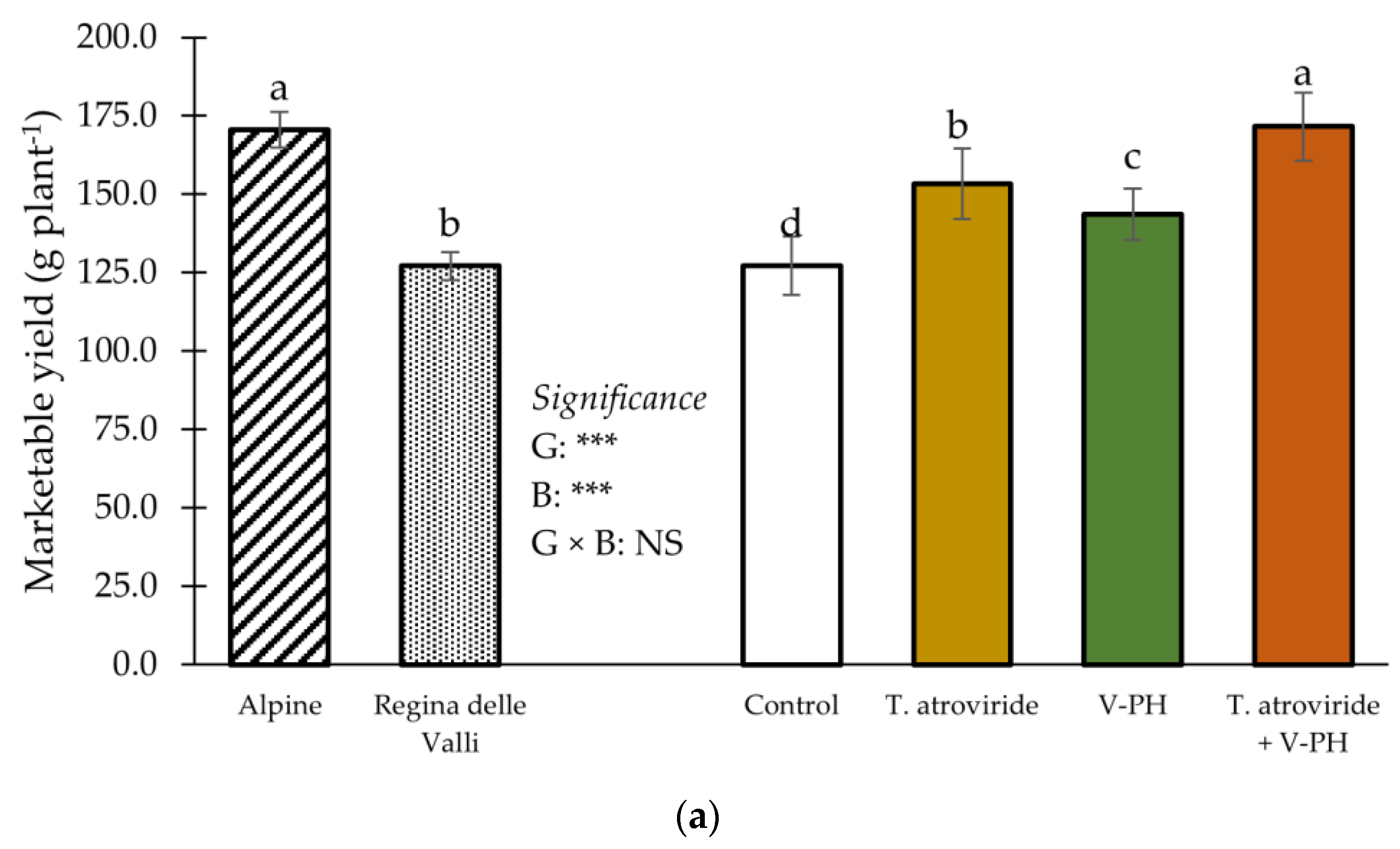
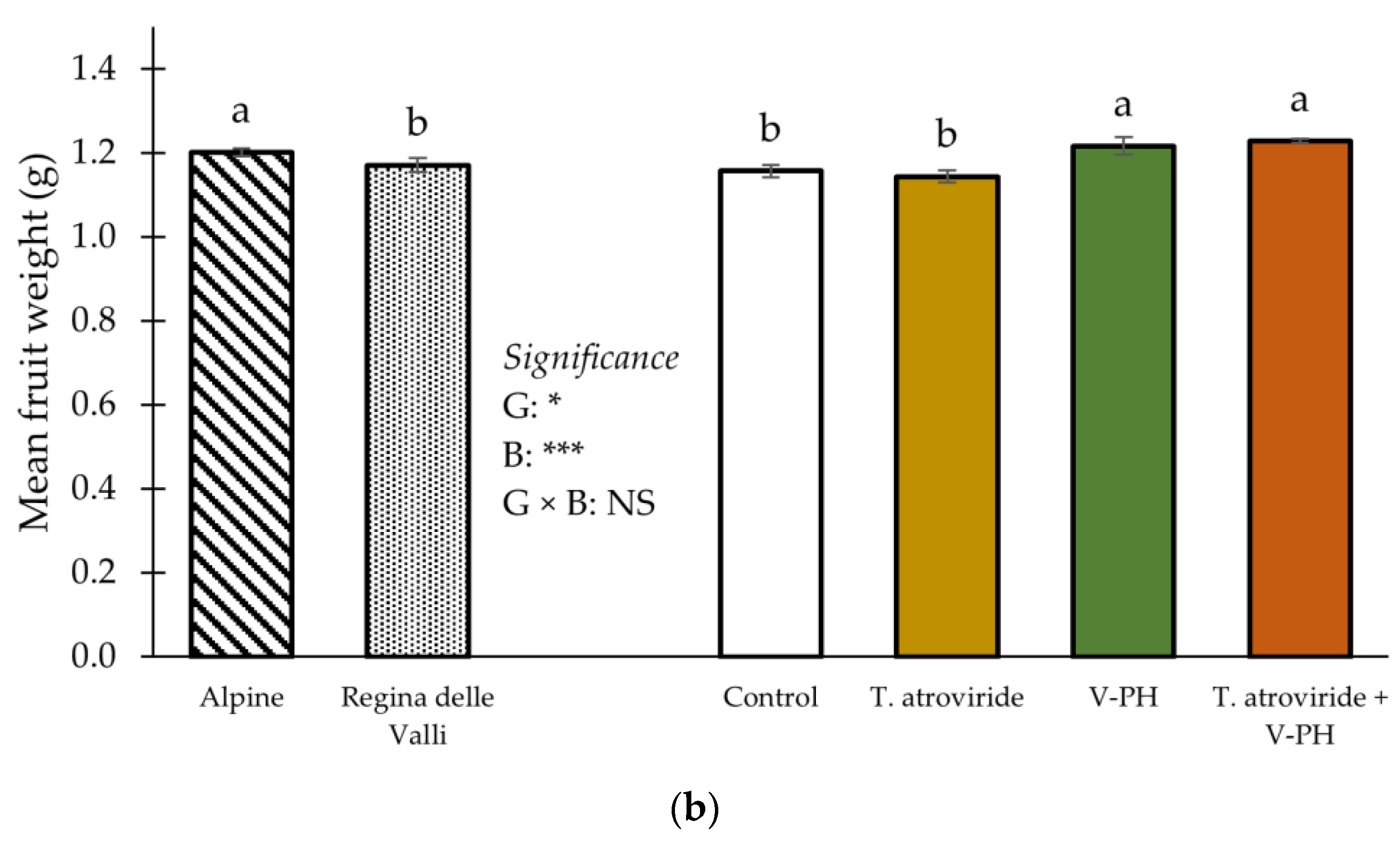
Figure 2.
Effect of genotype and biostimulant on Flavonoids (a), anthocyanins (b), total polyphenols (c), antioxidant activity (d) of wild strawberry grown in a soilless cultivation system. Values with different letters significantly differ at p ≤ 0.05. N.S., *, **, *** non-significant or significant at 0.05 or 0.005 and 0.001, respectively.
Figure 2.
Effect of genotype and biostimulant on Flavonoids (a), anthocyanins (b), total polyphenols (c), antioxidant activity (d) of wild strawberry grown in a soilless cultivation system. Values with different letters significantly differ at p ≤ 0.05. N.S., *, **, *** non-significant or significant at 0.05 or 0.005 and 0.001, respectively.
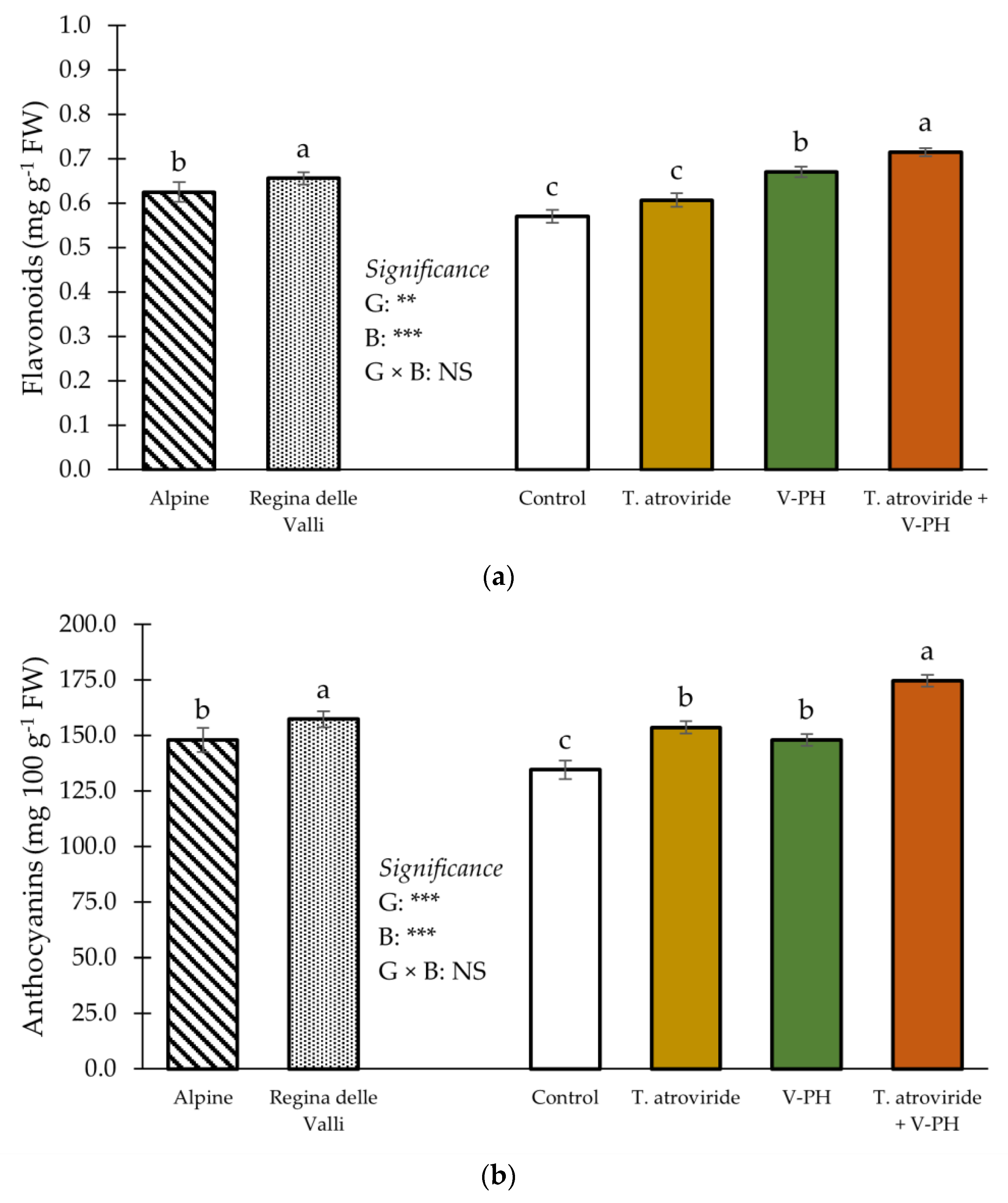
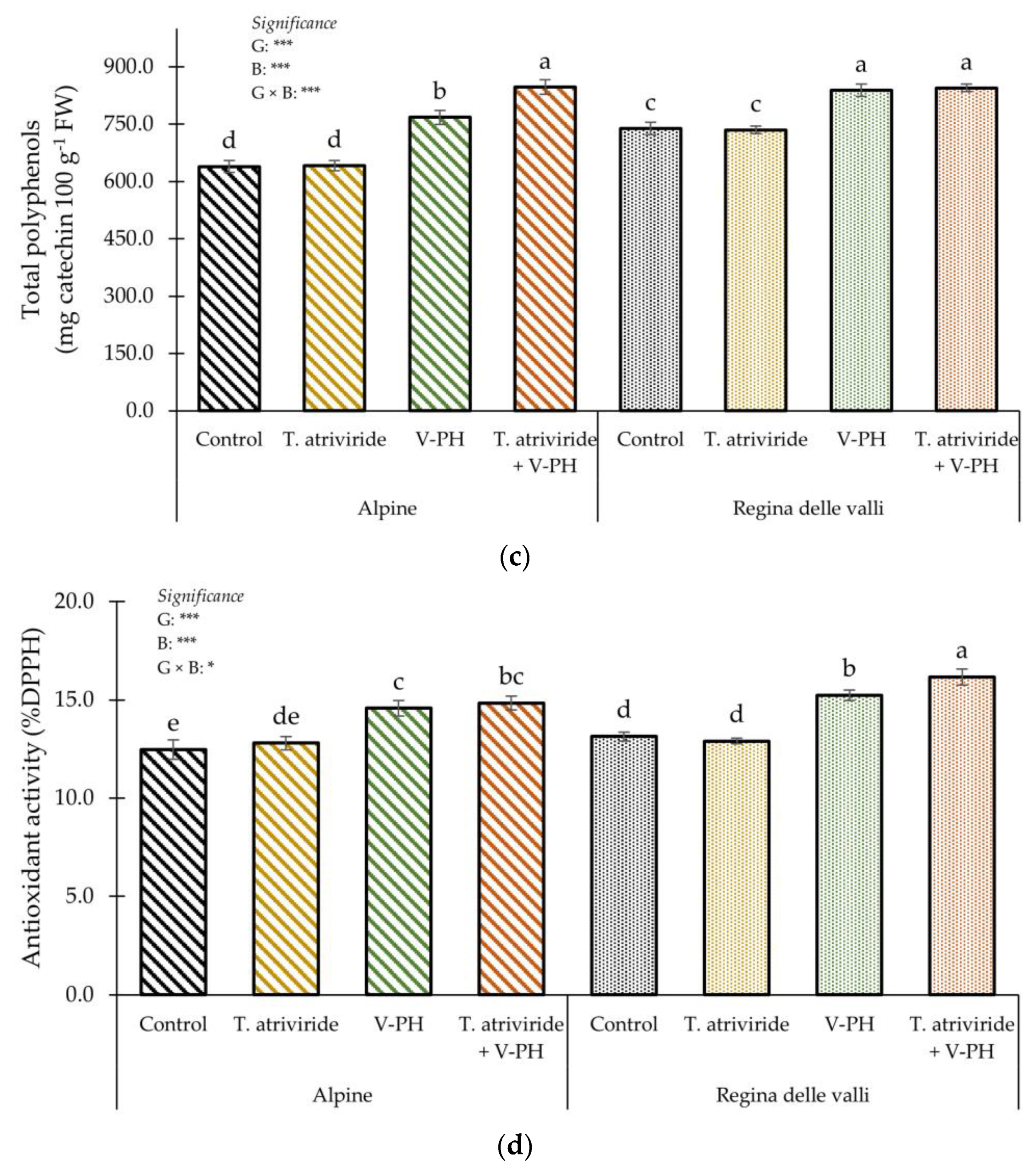
Figure 3.
Heat map analysis including all wild strawberry plant traits in response of genotype and biostimulants treatments. The heat map figure was created using the https://biit.cs.ut.ee/clustvis/online program (accessed on 01 February, 2024) package. A: ‘Alpine’; RDV: ‘Regina delle Valli’.
Figure 3.
Heat map analysis including all wild strawberry plant traits in response of genotype and biostimulants treatments. The heat map figure was created using the https://biit.cs.ut.ee/clustvis/online program (accessed on 01 February, 2024) package. A: ‘Alpine’; RDV: ‘Regina delle Valli’.
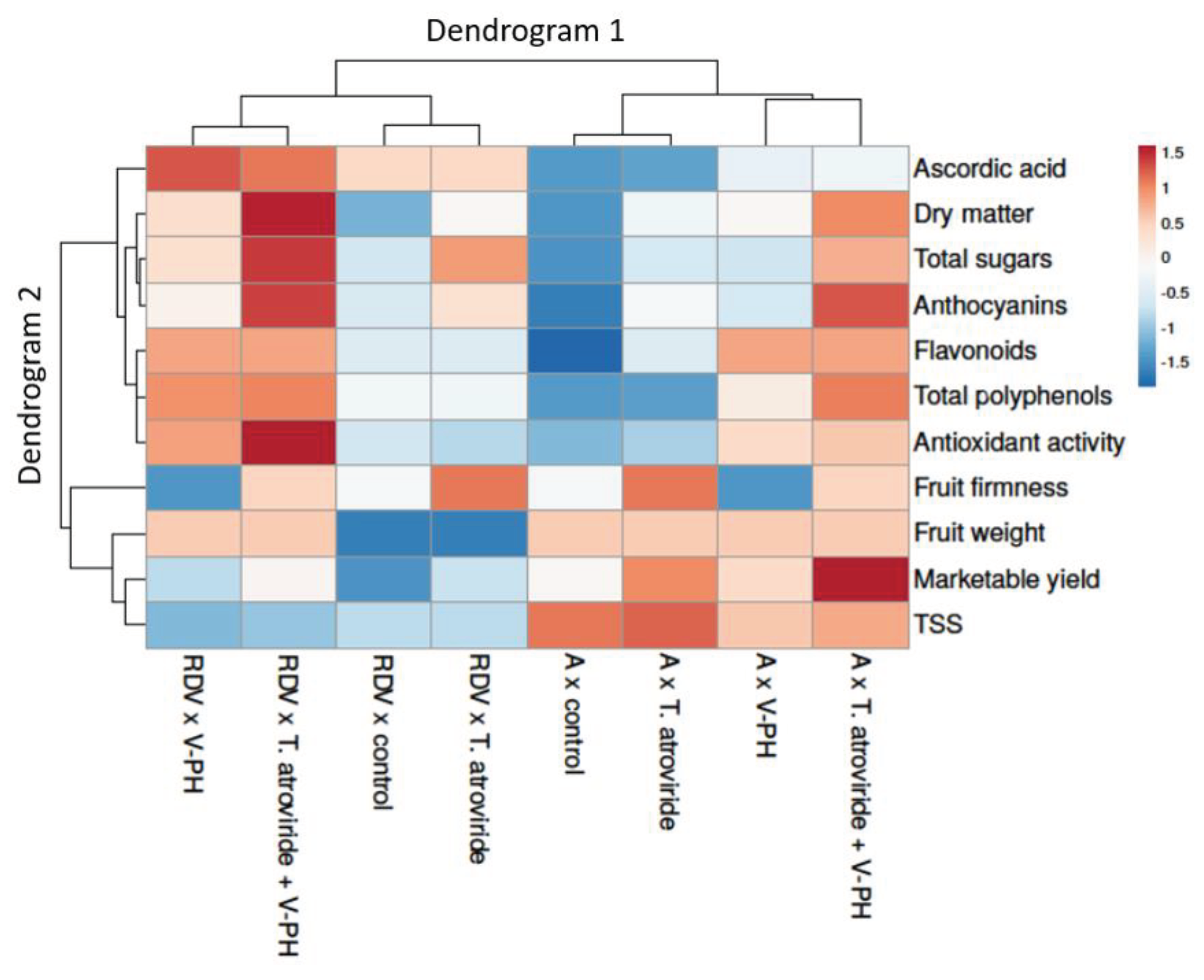
Table 1.
Effect of genotype and biostimulant on fruit dry matter, fruit firmness, TSS, total sugars and ascorbic acids of wild strawberry grown in a soilless cultivation system.
Table 1.
Effect of genotype and biostimulant on fruit dry matter, fruit firmness, TSS, total sugars and ascorbic acids of wild strawberry grown in a soilless cultivation system.
| Treatments | Fruit dry matter (%) | Fruit firmness (N) | TSS (°Brix) | Total sugars (mg 100 g-1 fw) | Ascorbic acid (mg 100 g-1 fw) | |||||
|---|---|---|---|---|---|---|---|---|---|---|
| Genotype (G) | ||||||||||
| Alpine | 32.3 | b | 1.13 | a | 12.13 | a | 8715.1 | b | 18.8 | b |
| Regina delle Valli | 32.9 | a | 1.10 | b | 10.39 | b | 8855.7 | a | 23.2 | a |
| Biostimulants (B) | ||||||||||
| Control | 30.5 | c | 1.11 | c | 11.42 | a | 8638.6 | c | 19.7 | b |
| T. atriviride | 32.3 | b | 1.27 | a | 11.45 | a | 8805.6 | b | 19.9 | b |
| V-PH | 32.9 | b | 0.90 | d | 11.02 | b | 8760.5 | b | 22.3 | a |
| T. atriviride + V-PH | 34.7 | a | 1.17 | b | 11.15 | b | 8937.0 | a | 22.2 | a |
| Significance | ||||||||||
| G | ** | * | *** | *** | *** | |||||
| B | *** | *** | *** | *** | *** | |||||
| G × B | NS | NS | NS | NS | NS | |||||
Values within a column followed by different letters are significantly different at p ≤ 0.05. NS, *, ** *** non-significant or significant at 0.05 or at 0.005 and 0.001, respectively.
Table 2.
Added returns of woodland strawberry attained by T. atroviride, V-PH, or their combination (T. atroviride + V-PH) under greenhouse conditions (soilless system) compared to the untreated control.
Table 2.
Added returns of woodland strawberry attained by T. atroviride, V-PH, or their combination (T. atroviride + V-PH) under greenhouse conditions (soilless system) compared to the untreated control.
| Biostimulant | Yield Increase (kg ha-1) |
Price (€ kg-1) | Added Gross Return (€ ha-1) | Added Variable Cost (€ ha-1) | Added Net Return (€ ha-1) | |||
|---|---|---|---|---|---|---|---|---|
| Biostimulant Treatment | Application | Harvest | Total | |||||
| T. atroviride | 391.5 | 21.0 | 8221.5 | 150.0 | 70.0 | 1370.0 | 1590.0 | 6631.5 |
| V-PH | 246.0 | 21.0 | 5166.0 | 614.3 | 600.0 | 860.0 | 2074.3 | 3091.8 |
| T. atroviride + V-PH | 664.5 | 21.0 | 13954.5 | 764.3 | 670.0 | 2325.0 | 3759.3 | 10195.3 |
Disclaimer/Publisher’s Note: The statements, opinions and data contained in all publications are solely those of the individual author(s) and contributor(s) and not of MDPI and/or the editor(s). MDPI and/or the editor(s) disclaim responsibility for any injury to people or property resulting from any ideas, methods, instructions or products referred to in the content. |
© 2024 by the authors. Licensee MDPI, Basel, Switzerland. This article is an open access article distributed under the terms and conditions of the Creative Commons Attribution (CC BY) license (http://creativecommons.org/licenses/by/4.0/).
Copyright: This open access article is published under a Creative Commons CC BY 4.0 license, which permit the free download, distribution, and reuse, provided that the author and preprint are cited in any reuse.
Alerts
MDPI Initiatives
Important Links
© 2024 MDPI (Basel, Switzerland) unless otherwise stated







